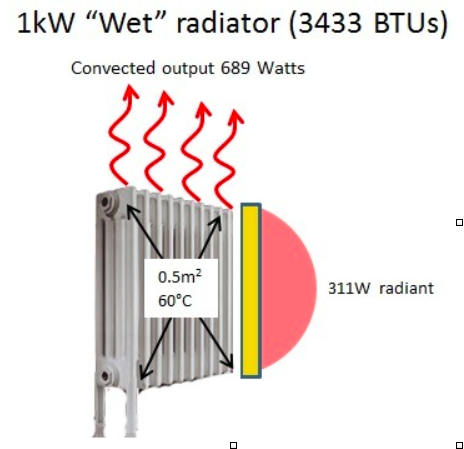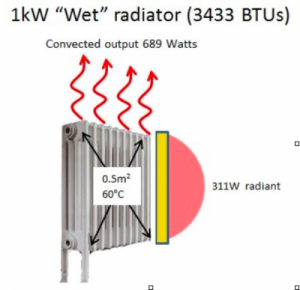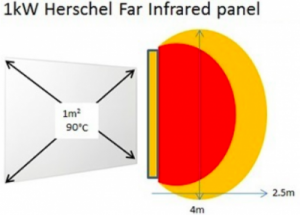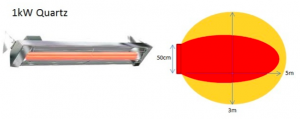
Radiant Heat v Convection Heat Transfer


This page compares radiant heat v convection heat transfer of heat generated. Comparing the traditional pumped hot water-filled convection Central heating system versus an Electric Radiant Heat heating system.
A kilowatt of energy does not produce the same amount of Heat Transfer, this is because each type of heating system has different heat transfer properties. The system with the lowest heat transfer capabilities will require higher capacity and will take much longer to reach the required target temperature than the system with the highest heat transfer capability. These factors impact the amount of energy used, and therefore the costs.
Conduction: Conduction is very efficient as the heat transfer is by direct contact for example Saucepan on the Hob so it is not suitable for space heating.
Convection: Currently the commonest form of space heating, the transfer of heat by the movement of liquid or gas using air as the medium. Convection occurs when air (or liquid) is heated, the hot air is less dense & lighter than cold air, and as such rises from its point of origin. This hot air cools as it moves away from the heat source, following the process of cooling the air becomes denser/heavier and falls back to ground level. This creates the convection current. In the traditional Central Heating system, hot water is heated in the boiler. Then pumped through the system of pipes and radiators. The heated radiator transfers heat to the air which then travels by convection up to the ceiling, cools and returns cold to the floor.
Air movement is not easy to control as heat transfer moves from hot to cold. If a draft is created by an open door, or poor window fitting warm, air will be sucked or blown away.
Convection currents only move upwards. So apart from the radiant heat transferred from the surface of the radiator, no benefits can be experienced from the sides of the radiator.
Air does not absorb or transfer heat well, it is difficult to zone as it disperses, and rapidly cools when radiators switch off.
The transfer of heat through electromagnetic radiation (See Infrared Wave Analysis)
This system has considerable advantages over convected heat for comfort heating because:
We are charged per kiloWatt of energy, however, this does not mean we get the same environmental heating effect regardless of the type of heat transfer method.
Here we compare 4 different types of heater, each rated at 1kW.

A traditional water-filled radiator panel has a BTU (British Thermal Unit) value rather than a Kilowatt value; 1 kW is approximately 3400 BTUs.
The 900mm x 620mm (0.55m2) single panel convector (3433 BTUs) above is the closest match to a 1kW radiant heater. This panel has a front area of 0.55m2 and at 60C will radiate 311 Watts at 8 – 15 microns (i.e. cool- see infrared wave analysis) and convect the remainder (689 Watts). When estimating rooms for a convection panel radiator, 40 watts are required per cubic metre. Thus a 1 kW convection heater will heat a room 25 m3 or approx 3mW x 4mL x 2.1mH.

A Herschel Far Infrared panel of 1m2 area at 90C radiates 0.9kW at 5-12 microns at the panel surface. The panel’s larger radiating surface emits up to 40% higher temperature for the same kilowatt input.
The radiant heat is felt directly on the skin in the “red” zone in front of the heater. Heat emanates out and heats the building or objects in the orange portion of the heat bloom.
Heat transfer occurs as the emitted radiant energy meets objects which absorb the energy. This is a more efficient form of heat transfer compared with convection. This is because a high percentage of energy is transferred into target objects. These retain the heat instead of into the surrounding air which loses heat rapidly. Consequently, a lower capacity IR heater is required and runs for a shorter time.
When estimating rooms for a Far Infrared Panel, 25 watts are required per cubic metre. Thus a 1 kW Far infrared panel heater will heat a room 40 m3 or approx 4.5mW x 4.2mL x 2.1mH. Note that a 625 Watt Far Infrared panel heater will heat a 25 m3 room which requires a 1kW convection panel radiator.

The Herschel Advantage IR2 space heater comprises 2 x 650W ceramic emitters giving a total output of 1.3kW, emitting 400C at 2 – 10 microns. (8-micron bandwidth). See Infrared Wavelength Analysis. This space heater heats people in open spaces up to 9 square meters, from 2.3 to 2.5m away. The heater runs at high temperatures. Suitable for open spaces as it is a very efficient heater in applications such as warehouse/workshop/packing station where draughts and vehicle movements have to be compensated for, and where other heaters are ineffective.

A 1kW quartz heater emits 1500C at 1-2 microns. (1-micron bandwidth) or shortwave. 1-2 microns is extremely hot (1500C) and is suitable for cooking meat and welding plastic. This type of heater is particularly useful where you need to throw heat. For example in outside patio & terrace areas where there is a lot of movement and weather. These would not be appropriate in an enclosed or small room, as the heat would be too intense and uncomfortable.
Manufacturers optimise their heaters to suit certain situations. Different 1kW heaters have a wide range of physical properties. Our website can guide you to the correct choice! We have an infrared heater for every application. For more advice, please contact us by email or telephone.

